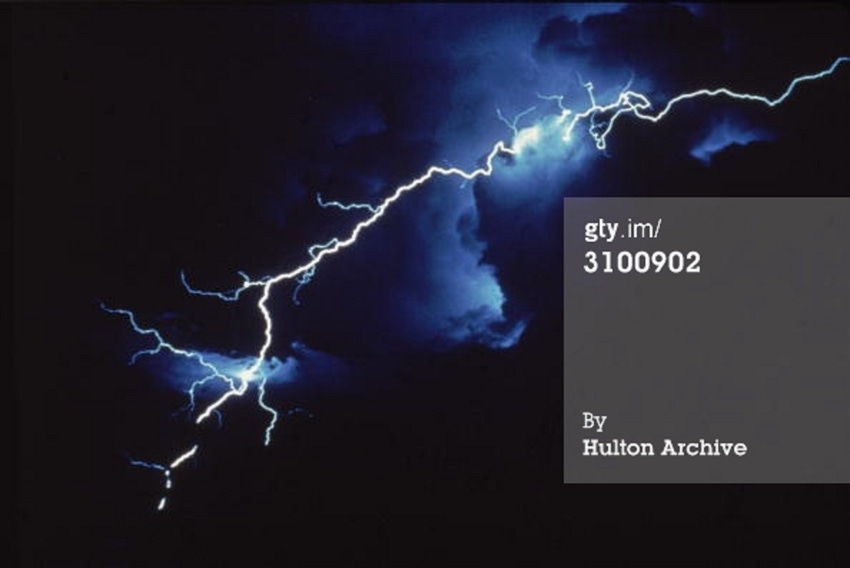
Almost everyone is aware of the potential power and intensity of a developing storm, especially if caught outdoors when serious cells of conflicted clouds begin to roll violently overhead in a darkening sky.
While most us understand the danger of being caught outdoors by tumultuous weather, most might be surprised to discover new climate models are now predicting an increase in the number of lightning strikes in the years ahead, the result of warming temperatures.
In the Nov. 14 issue of the journal Science, faculty climate scientist David Romps, University of California (UC) Berkeley, warned that after studying data and developing predictions related to precipitation and such factors as cloud buoyancy across multiple climate models, a marked increase in lightning strikes appears certain in the future.
"With warming, thunderstorms become more explosive," said Romps, who also serves as an assistant professor of earth and planetary science and a faculty scientist at Lawrence Berkeley National Laboratory. "This has to do with water vapor, which is the fuel for explosive deep convection in the atmosphere. Warming causes more water vapor in the atmosphere, and if you have more fuel lying around, when you get ignition, it can go big time."
For the latest on southwest agriculture, please check out Southwest Farm Press Daily and receive the latest news right to your inbox.
Romps' predictions, the result of cooperative research with a number of colleagues, represent a pioneering effort in determining long-range forecasts of weather-related electrical activity. While previous studies have shown changes in lightning associated with seasonal or year-to-year variations in temperature, no reliable analyses have been available for an extended period of warmer weather and its influence on lightning activity.
Researchers plotted lightning strike data across the U.S. for August and September of 2011 and set about animating the data to determine contributing factors to heightened electrical activity. This data led researchers to better base predictions for long-range lightning activity in the future.
Caution urged on farm and ranch
"Lightning is caused by charge separation within clouds, and to maximize charge separation, you have to loft more water vapor and heavy ice particles into the atmosphere," Romps said. "We already know that the faster the updrafts, the more lightning, and the more precipitation, the more lightning."
For farmers and ranchers who spend much of their time outdoors, early warning of developing serious weather events can help protect property and save lives. Statistics vary greatly from year to year, but researchers say hundreds to as many as a thousand human lightning strike events are reported across the U.S., and lives are lost each year. With Romps’ prediction of a 50 percent increase in lightning strike probability in the years ahead, those numbers are only going to rise.
Another significant factor related to an increased number of lightning strikes is the threat of increased wildfires started by weather events. Research indicates half of all fires are ignited by lightning and that lightning-caused wildfires are often the hardest to fight and the most difficult to access in rural or wilderness areas.
Yet another potential problem is that increased lightning would likely generate more nitrogen oxides in the atmosphere, which exert a strong control on atmospheric chemistry. Scientists say determining those long term effects will require additional study.
Romps says precipitation, or the total amount of water hitting the ground in the form of rain, snow, hail or other forms, is basically a measure of how convective the atmosphere can become, and he says convection is what generates lightning.
The ascent speeds of those convective clouds are determined by a factor called convective available potential energy, or CAPE, which is measured by balloon-borne instruments, called radiosondes, released around the United States twice a day.
"CAPE is a measure of how potentially explosive the atmosphere is, that is, how buoyant a parcel of air would be if you got it convecting, if you got it to punch through overlying air into the free troposphere," Romps said. “We hypothesized that the product of precipitation and CAPE would predict lightning.”
Using U.S. Weather Service data on precipitation, radiosonde measurements of CAPE and lightning-strike counts from the National Lightning Detection Network at the University of Albany, State University of New York (UAlbany), they concluded that 77 percent of the variations in lightning strikes could be predicted from knowing just these two parameters.
Accurate predictions
"We were blown away by how incredibly well that worked to predict lightning strikes," he said.
In the future, Romps plans to look at the distribution of lightning-strike increases around the U.S. and also to explore what lightning data can tell climatologists about atmospheric convection.
Romps’ co-authors are Jacob Seeley, also of the Department of Earth and Planetary Science at UC Berkeley, and David Vollaro and John Molinari of the Department of Atmospheric and Environmental Sciences at UAlbany.
The work was supported by the U.S. Department of Energy’s Office of Advanced Scientific Computing Research and Office of Biological and Environmental Research, and the National Science Foundation.
About the Author(s)
You May Also Like




